Batteries are an essential component of many modern devices, from smartphones to electric cars. With so many battery technologies available, it can be challenging to choose the right one for your needs. Two popular types of rechargeable batteries are Lithium-Ion (Li-ion) and Lithium Iron Phosphate (LiFePO4). In this article, we’ll compare LiFePO4 vs Lithium-Ion batteries to make it clear the differences.
Section 1: What are Lifepo4 Batteries?
Lithium Iron Phosphate (Lifepo4) batteries are a type of rechargeable battery that uses Lithium Iron Phosphate as its cathode material. This type of battery has a high energy density, meaning it can store a lot of energy in a small package. They also have a longer lifespan than most other battery types and perform better in extreme temperatures.

History of Lithium Iron Phosphate (LiFePO4) Batteries
LiFePO4 batteries have been in existence for over two decades and were first developed by researchers at the University of Texas in the late 1990s. Their breakthrough with LiFePO4 batteries pointed towards a safer, more efficient alternative to lead-acid batteries, which were the most commonly used batteries at that time.
One of the most significant developments in the history of LiFePO4 batteries was the discovery that the material could improve the safety, stability, and energy density of lithium-ion batteries. In 1996, Dr. John Goodenough and his colleagues at the University of Texas published a paper in the Journal of the Electrochemical Society that fundamentally changed the way we use batteries today.
Since the initial research, many companies have started to manufacture LiFePO4 batteries, providing consumers with a wide range of applications, including cars, electric motorcycles, drones, and power storage systems.
Today, LiFePO4 batteries are an excellent choice for a range of different applications due to their high energy density, long life, and enhanced safety. They have undoubtedly come a long way since their inception and continue to be researched and improved upon.
Section 2: What are Lithium-Ion Batteries?
Lithium-Ion batteries are a type of rechargeable battery that uses Lithium Cobalt Oxide (LCO), Lithium Manganese Oxide (LMO), or Lithium Nickel Cobalt Aluminum Oxide (NCA) as their cathode material. They are widely used in consumer electronics, electric vehicles, and renewable energy storage systems.
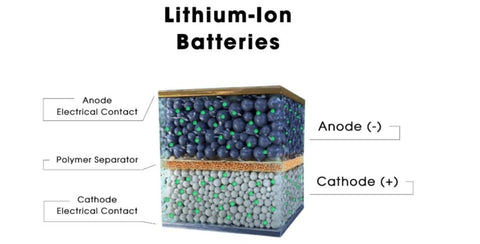
Section 3: Lifepo4 vs Lithium-Ion Batteries: A Comparison
When comparing lifepo4 battery vs lithium-ion, it's important to consider factors such as safety, lifespan, cost and so on. Below is a format that shows the differences that lithium phosphate battery vs lithium-ion batteries.

Note: The above comparison is based on general characteristics and may vary depending on the specific make and model of the battery.
Cost
The price of LiFePO4 and Li-ion batteries per watt-hour can differ significantly depending on the manufacturer, market demand, and capacity. LiFePO4 batteries do not use nickel or cobalt, which are materials that can experience considerable supply and price fluctuations.
While LiFePO4 is a newer battery chemistry, and there are fewer manufacturers and less supply available, this can result in slightly higher costs compared to Li-ion battery packs.
However, despite the potentially higher cost, the benefits of LFP far outweigh the difference in price. The added expenses go towards ensuring added safety, longer lifespan, and other invaluable advantages. The LiTime 12V 200AH lithium iron phosphate battery with a unit price of $629.99 has a service life of more than 10 years, and the average annual price is only about $63.
LFP batteries are also becoming increasingly affordable, with a lower cost per kWh compared to other lithium-ion chemistries.
Self-Discharge Rate
The self-discharge rate of a battery is the measure of how much energy it loses over time when it is not in use. All batteries undergo some degree of self-discharge, which occurs due to internal chemical reactions that continue even when the battery is not being used.
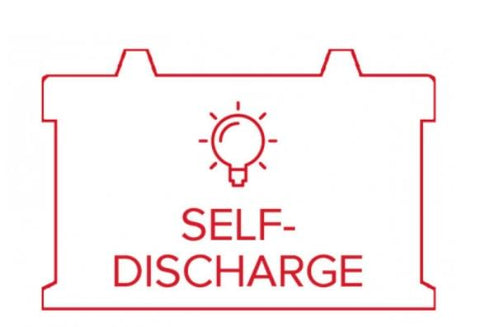
A battery with a high self-discharge rate will lose its charge more quickly than a battery with a low self-discharge rate. This can be an issue for devices that are used infrequently or where the battery needs to be stored for an extended period.
Lithium iron phosphate batteries have a self-discharge rate of approximately 1-3% per month. This implies that if the battery remains fully charged and unused for a month, its battery capacity will range between 99%-97%, depending on several factors such as temperature, usage, among others. Li-ion rechargeable batteries have a self-discharge rate typically stated by manufacturers to be 1.5–2% per month. The low self-discharge rate makes them possible to store the battery for several months without compromising its performance.
To guarantee optimal performance, it is advisable to recharge the battery every few months to maintain its top condition.
Lifespan
Whereas lithium-ion batteries can undergo approximately 500 charge and discharge cycles (about 2-3 years) before facing performance degradation, LiFePO4 batteries can last through thousands of cycles while retaining their optimum performance.
Take, for instance, the LiTime 12V 100AH mini LiFePO4 battery. It boasts a rated cycle life exceeding 80% after up to 4000 cycles. Even after this long period, the battery still retains at least 80% of its initial 1280 kWh capacity. Moreover, even though there may be a slight drop in performance, your LFP battery pack will remain functional for several more years.
The longer lifespan of LiFePO4 batteries reduces environmental e-waste impact, and their lack of cobalt and nickel makes them a more eco-friendly option.
Compared to Li-ion packs, LFP battery packs last up to 5 or 6 times longer, which saves you money on replacement batteries.
Safety
LiFePO4 batteries are considered safer than Li-ion batteries due to the strong covalent bonds between the iron, phosphorus, and oxygen atoms present in their cathode. These bonds make them highly stable and less prone to overheating and thermal runaway - issues that have contributed to the reputation of lithium-ion batteries for their higher risk of battery fires.

This enhanced stability is precisely why LFPs are the standard when it comes to off-grid and solar power applications. In home settings, there is no room for errors related to overheating or other safety concerns. As a result, homeowners can confidently store their LiFePO4 batteries in their homes without worrying about any fire safety issues.
LiFePO4 (Lithium Iron Phosphate) batteries are considered safer than other lithium-ion batteries for several reasons:
-
Thermal Stability: LiFePO4 batteries are more thermally stable compared to other lithium-ion chemistries. They are less prone to thermal runaway, a condition where the battery temperature increases uncontrollably, potentially leading to fire or explosion. This enhanced thermal stability makes LiFePO4 batteries less susceptible to overheating and related safety hazards.
-
Chemical Stability: The chemical structure of LiFePO4 is inherently more stable than other lithium-ion chemistries, reducing the likelihood of the battery undergoing uncontrolled reactions that could lead to safety issues.
-
Lower Risk of Fire: Due to their stable chemical and thermal properties, LiFePO4 batteries have a lower risk of catching fire or exploding compared to other lithium-ion chemistries, especially when subjected to abusive conditions such as overcharging or physical damage.
-
Longer Cycle Life: LiFePO4 batteries typically have a longer cycle life compared to other lithium-ion batteries, meaning they can undergo a greater number of charge-discharge cycles before experiencing significant degradation. This longevity contributes to their overall safety by reducing the frequency of battery replacements and potential failure points.
-
Environmental Friendliness: LiFePO4 batteries are considered more environmentally friendly than other lithium-ion chemistries due to the absence of cobalt in their composition. Cobalt, commonly found in other lithium-ion batteries, has environmental and ethical concerns related to its mining and supply chain.
Energy Density
Energy density refers to the amount of energy that a battery can store per unit of its weight or volume. In other words, it is the measure of how much energy a battery can hold relative to its size or weight. A higher energy density means that a battery can store more energy in a smaller space or with less weight.

In comparison to LiFePO4 batteries, Li-ion batteries generally have a higher energy density. This means that they can store more energy in a smaller volume or weight. For example, the energy density of a typical Li-ion battery ranges from 100-200 Watt-hours per kilogram (Wh/kg).
In contrast, the energy density of LiFePO4 batteries is relatively lower than that of Li-ion batteries, but it still offers many advantages. The specific energy density of a standard LFP cell is typically around 90–110 Wh/kg. However, even with the lower energy density, LFP batteries have several benefits over Li-ion batteries such as longer cycle life, better temperature performance, greater safety, and being more environmentally friendly.
For instance, an electric vehicle powered by a 60 kWh Li-ion battery pack could travel up to 230 miles. However, using an LFP battery with the same capacity would allow the vehicle to travel up to 180 miles. While this represents a decrease in range, it's important to note that LFP batteries are still a viable option for many applications where high energy density is not the priority.
LiFePO4 still remains the most suitable option for off-grid power solutions, even when comparing its slightly lower energy density to Li-ion batteries. As you move towards larger stationary power solutions, the difference in energy density becomes negligible
Temperature Range
Compared to Li-ion batteries, LiFePO4 batteries offer a significantly wider operating temperature range. They can perform optimally in temperatures ranging -20℃ to 60℃ / -4℉ to 140℉.
In contrast, Li-ion batteries have a much narrower temperature range of 32°F (0°C) to 113°F (45°C). As a result, users may need to store Li-ion batteries in climate-controlled spaces during extreme weather conditions such as the depths of winter or heatwaves in summer.
LiFePO4 batteries are suitable for storage in indoor spaces such as houses, garages, or sheds, without requiring air conditioning. Their resistance to temperature changes makes them less susceptible to damage, allowing for more flexibility in locating the battery without concerns about reduced efficiency or potential harm.
Depth of Discharge (DOD)
The depth of discharge (DOD) is a measure of the amount of energy that has been discharged from a battery compared to its total capacity. It is expressed as a percentage and indicates how much of the battery's total charge has been used.

For example, if a 100Ah battery is discharged by 50Ah, its depth of discharge is 50% (50Ah ÷ 100Ah × 100% = 50%). If the same battery is discharged by 80Ah, its DOD will be 80% (80Ah ÷ 100Ah × 100% = 80%). A higher depth of discharge indicates a broader performance range for the battery as you are using more of its stored energy.
Li-ion batteries offer a depth of discharge ranging from 80% to 95%. As a result, it's essential to leave behind at least 5% to 20% charge (depending on the specific battery) in the battery at all times.
On the other hand, LiFePO4 batteries stand out with an impressive 100% depth of discharge. This means that they can be entirely drained without any concerns about damaging the battery.
In conclusion, when it comes to depth of discharge, Lithium Iron Phosphate batteries are the clear winners. It's worth noting that all lithium-based batteries have considerably higher DOD compared to lead-acid batteries, which only offer a DOD of 50%.
Weight
The weight of a battery can significantly impact its performance in applications such as electric motors.
Lithium-ion batteries typically contain high-density materials like lithium manganese oxide and lithium cobalt oxide, which contribute to their heavier weight.
In contrast, Lithium iron phosphate batteries contain compounds of iron, which are considerably lighter than the metals used in lithium-ion batteries.
As a result, the verdict is that Lithium iron batteries weigh less than an equivalent capacity lithium-ion battery, with an average difference of about 50%.
Environmental Concerns

Lithium iron phosphate (LiFePO4) batteries are generally considered to be more environmentally friendly than lithium-ion (Li-ion) batteries. There are three key reasons for this:
- Less Toxic Materials: LiFePO4 batteries contain less toxic materials compared to Li-ion batteries, which often include heavy metals like cobalt and nickel. The extraction and disposal of these metals have significant environmental impacts such as pollution and habitat destruction.
- Longer Lifespan: LiFePO4 batteries have a longer lifespan compared to Li-ion batteries. This means that fewer batteries need to be manufactured, reducing the amount of waste generated from battery production and disposal.
- Safer Disposal: LiFePO4 batteries can be disposed of in regular trash since they do not contain toxic materials, while Li-ion batteries require special handling and recycling procedures to prevent environmental damage.
Overall, LiFePO4 batteries offer a more eco-friendly solution compared to Li-ion batteries. Their lower toxicity, longer lifespan, and safer disposal make them a better choice for applications where environmental concerns are a priority.
Voltage
Li-ion batteries typically have a nominal voltage of 3.6-3.7 volts per cell, with a fully charged voltage of 4.2 volts per cell. This means that a typical Li-ion battery pack consisting of several cells in series will have a voltage range of 7.2-8.4 volts for a 2-cell pack, 10.8-12.6 volts for a 3-cell pack, and so on.
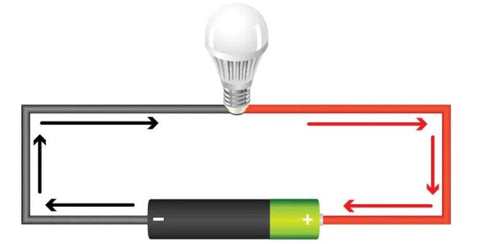
In contrast, LiFePO4 batteries have a nominal voltage of 3.2 volts per cell, with a fully charged voltage of 3.65 volts per cell. This means that a typical LiFePO4 battery pack consisting of several cells in series will have a voltage range of 6.4-7.3 volts for a 2-cell pack, 9.6-10.9 volts for a 3-cell pack, and so on.
Therefore, Li-ion batteries tend to have a higher voltage compared to LiFePO4 batteries, which can impact their performance and application suitability. The lower voltage of LiFePO4 batteries may result in a slightly reduced power output but offers some advantages such as longer lifespan and better temperature stability.
Thermal stability
Thermal stability refers to a battery's ability to maintain its structural integrity and avoid thermal runaway under high-temperature conditions. In other words, it is the ability of a battery to resist overheating and prevent dangerous situations such as fires or explosions.
Lithium-ion batteries are well-known for their tendency to overheat easily, and there have been instances of lithium manganese oxide batteries exploding in laptops. These batteries are also prone to thermal runaway.
In contrast, LiFePO4 batteries are 100% non-flammable, which means that there is no risk of them catching fire or exploding. These batteries do not overheat regardless of the charging method used, and they do not exhibit any thermal runaway.
Section 4: Lifepo4 vs Lithium-Ion batteries: Real World Applications
Both LiFePO4 and Li-ion batteries have numerous applications in many industries, including consumer electronics, automotive, renewable energy, and more. Here are some examples of real-world applications for lithium ion vs LiFePO4 batteries.
Examples of real-world applications for LiFePO4 batteries:
-
Off-grid and solar power systems
-
Electric vehicles
-
Energy storage for residential and commercial buildings
-
Marine , RV and Golf Cart applications
-
Medical equipment
-
Unmanned Aerial Vehicles (UAVs)
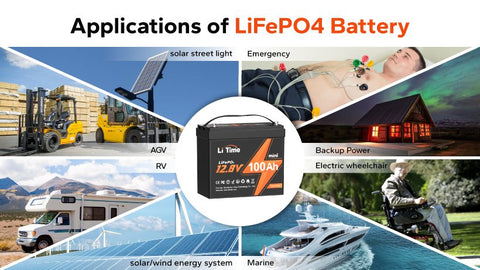
Examples of real-world applications for Lithium-Ion batteries:
-
Laptops, smartphones, and other portable electronic devices
- Electric bicycles
- Power tools
- Hybrid and plug-in electric vehicles
- Drones
- Portable backup power supplies
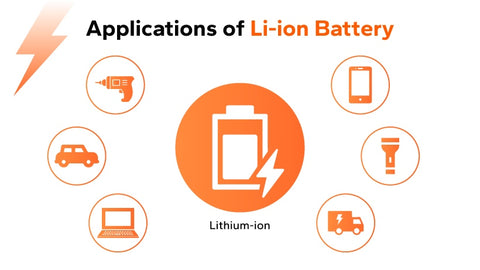
Analysis of which type of battery is better suited for which applications: The choice between LiFePO4 and Li-ion batteries depends on the specific application's priorities and requirements. For example, Li-ion batteries have a higher energy density and can store more energy in a smaller space, making them ideal for portable electronics and electric vehicles. On the other hand, LiFePO4 batteries offer longer lifespan, better safety, wider temperature range, and more eco-friendliness, making them suitable for off-grid power, energy storage systems, and marine and RV applications.
In conclusion, the selection of a battery type depends on the specific application's needs. While Li-ion batteries are more commonly used in portable electronics and electric vehicles, LiFePO4 batteries are a better fit for renewable energy and off-grid power applications that require greater safety, longer lifespan, and wider temperature range.
Section 5: Is Lithium Battery Superior to Non-Lithium Alternatives
The comparison between lithium iron phosphate batteries and lithium-ion batteries favors the former. However, when compared to non-lithium batteries, lithium cells win by a significant margin.
Lead Acid Batteries
Lead-acid batteries have been widely used in automotive starter batteries and UPS batteries. However, lithium batteries are increasingly taking over their market share.
Although lead-acid batteries are less expensive, lithium batteries can last up to ten times longer. Additionally, lead-acid batteries require regular maintenance such as electrolyte top-up and terminal maintenance, which is not necessary for lithium batteries.
For an in-depth comparison between the two types, our guide on LiFePO4 vs Lead-Acid battery provides detailed information.
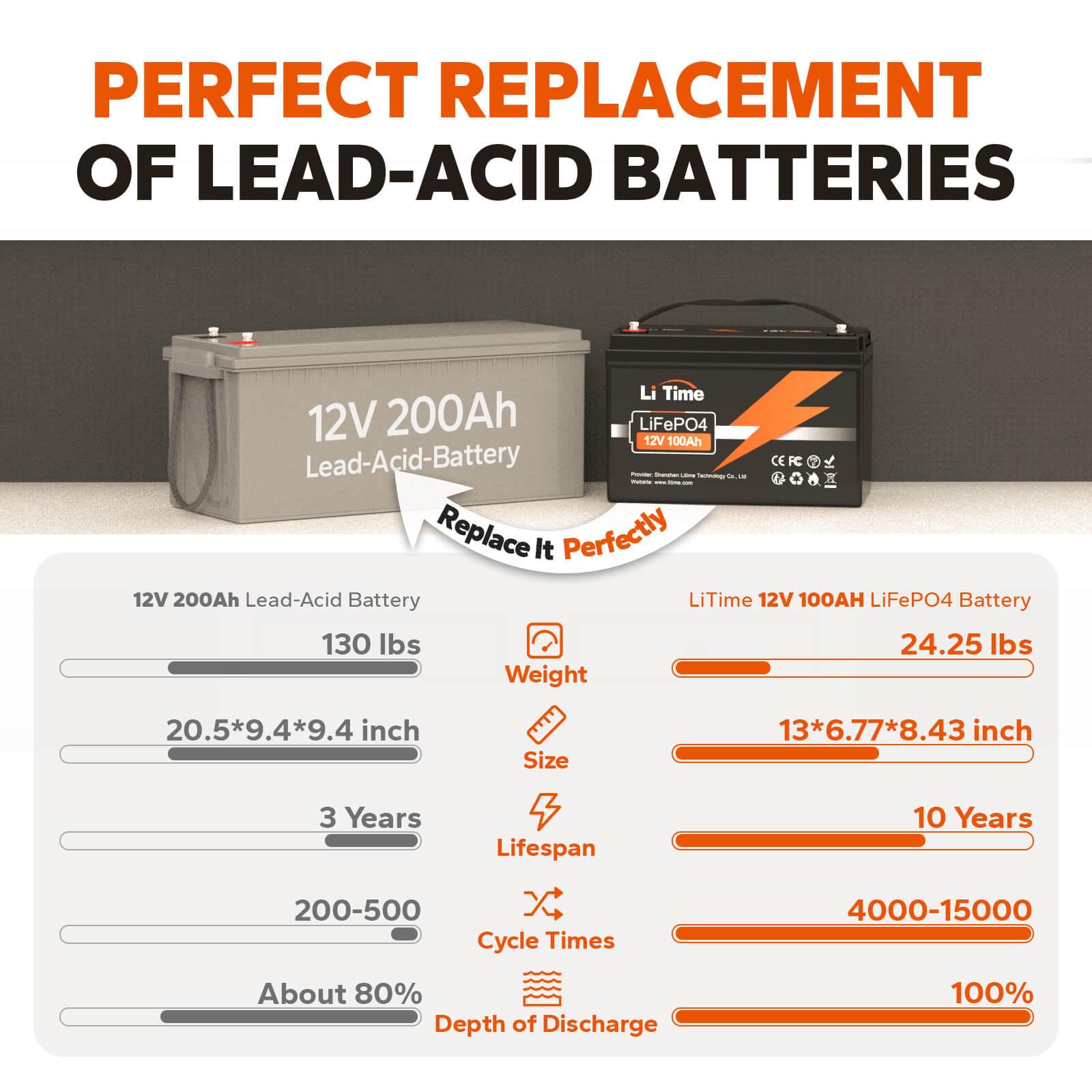
LiTime 12V 100Ah LiFePO4 lithium Battery
Gel Batteries
Gel batteries were developed as an improvement over lead-acid batteries with a sealed construction that doesn't require electrolyte top-up.
However, compared to lithium batteries, they still fall far behind. A lithium battery lasts longer than gel batteries, and gel batteries require special provisions like venting in the battery compartment, which is not required for lithium batteries.
There are many advantages of lithium batteries compared to gel batteries.
AGM Batteries
AGM batteries are one of the newest battery types that have become widely adopted to replace lead-acid and gel batteries.
However, their performance pales in comparison to lithium batteries. Lithium-based batteries, especially LiFePO4 batteries, last six times longer and offer a higher depth of discharge.
Although lead-acid batteries had the advantage of being much cheaper, AGM batteries are expensive. Therefore, regardless of the application you consider, choosing LiFePO4 batteries over AGM is a better option.
If you're in the market for a new battery, we recommend checking out LiTime's range of LiFePO4 batteries. Not only do they come with a 5-year warranty, but they're also equipped with BMS.
FAQs about LiFePO4 and Li-ion Battery
1. Can LiFePO4 batteries be used as a direct replacement for Li-ion batteries in all applications?
While LiFePO4 batteries have many advantages over Li-ion batteries, they may not be the best choice for all applications. Li-ion batteries still have a higher energy density, which makes them better suited for portable electronics and other low-power applications where weight and size are key factors. It is important to consider the specific requirements of each application when selecting the best battery type.
2. Can LiFePO4 catch fire?
Compared to other lithium batteries, LiFePO4 batteries are the safest option as they are not prone to overheating or catching fire. Even if the battery is punctured, it will not catch fire, which is a significant improvement over other types of lithium batteries that can be a fire hazard due to overheating.
3. Why is LiFePO4 so expensive?
LiFePO4 batteries are generally more expensive than other types of batteries due to several reasons:
-
Higher manufacturing cost: The production process of LiFePO4 batteries is complex and requires expensive raw materials, which drives up the manufacturing costs.
-
Limited availability of raw materials: The production of LiFePO4 batteries relies on limited raw materials such as lithium and iron, which can be expensive and subject to supply chain disruptions. The scarcity of these materials can cause price fluctuations and increase the overall cost of the battery.
-
Advanced technology: LiFePO4 batteries use advanced technology that requires sophisticated manufacturing equipment and processes, which can be expensive to acquire and maintain.
-
High-performance capabilities: LiFePO4 batteries offer higher energy density, longer lifespan, and greater safety compared to other types of batteries. These benefits come at a premium cost, making them more expensive than other options.
While LiFePO4 batteries can be initially more expensive than other battery types, their longer lifespan and increased safety make them a more cost-effective option in the long run. As the technology continues to improve and manufacturing volume increases, the cost of LiFePO4 batteries is expected to decrease over time.
Additionally, LiTime provides tech-driven best value LiFePO4 lithium Batteries to make it easier replace the out-dated AGM batteries. This not only enhances the safety and longevity of energy storage systems but also aligns with the broader trend of transitioning to more efficient and sustainable battery technologies. As a result, the long-term benefits of LiFePO4 batteries, including their enhanced safety and extended lifespan, make them a prudent investment for RV, Marine, Golf Cart and home energy backup.

LiTime 36V 55Ah Trolling Motor Lithium Battery
Conclusion
In conclusion, LiFePO4 and Li-ion batteries are two popular choices for a variety of applications. While both have their benefits and drawbacks, there are some notable differences that set them apart.
On one hand, Li-ion batteries have a higher energy density and can store more energy in a smaller space.
On the other hand, LiFePO4 batteries offer a longer lifespan, better safety, wider temperature range, and more eco-friendliness compared to Li-ion batteries. If you need LiFePO4 deep cycle battery, LiTime will always be your trustworthy choice by offering grade A cell LiFePO4 batteries and high-qualified service.
---------------------------------------------------------------------------------------
You may also like
<<<What Size Battery for Trolling Motor
<<< LiFePO4 Lithium Batteries In Series VS Parallel: How-To & Everything You Need To Know

























































































































































